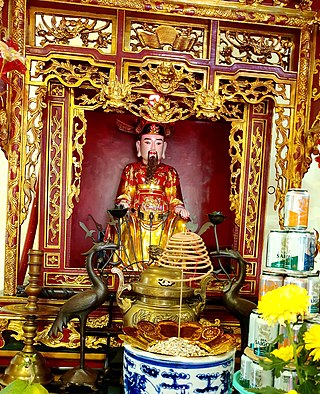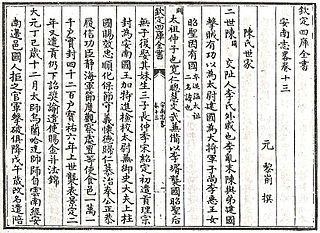Related Research Articles

Lý Nhân Tông, personal name Lý Càn Đức, temple name Nhân Tông was the fourth emperor of the Lý dynasty, ruling the kingdom of Đại Việt from 1072 until his death in 1128. Succeeding his father Lý Thánh Tông at the age of 7, during his early reign Lý Nhân Tông ruled with the assistance of his mother Ỷ Lan and the chancellor Lý Đạo Thành who were both considered competent regents and were able to help the emperor maintain the country's prosperity. Appreciated as a great emperor of the Lý dynasty, Lý Nhân Tông made important contributions to the development of Đại Việt, especially for establishing Confucianism as the official philosophy of the state, creating Confucian-based imperial exams, and creating schools based on the Confucian system of learning. During his 55-year reign, which was the longest reign for any Vietnamese monarch, Lý Nhân Tông also experienced several wars against Đại Việt's neighbours, the Song dynasty and the kingdom of Champa in which the Sino–Vietnamese War (1075–1076) was the fiercest. After his death, the royal family lost their control over the court to the chancellors and the bureaucracies.

The Đại Việt sử ký toàn thư is the official national chronicle of the Đại Việt, that was originally compiled by the royal historian Ngô Sĩ Liên under the order of the Emperor Lê Thánh Tông and was finished in 1479 during the Lê period. The 15-volume book covered the period from Hồng Bàng dynasty to the coronation of Lê Thái Tổ, the first emperor of the Lê dynasty in 1428. In compiling his work, Ngô Sĩ Liên based on two principal historical sources which were Đại Việt sử ký by Lê Văn Hưu and Đại Việt sử ký tục biên by Phan Phu Tiên. After its publication, Đại Việt sử ký toàn thư was continually supplemented by other historians of the royal court such as Vũ Quỳnh and Phạm Công Trứ. Today the most popular version of Đại Việt sử ký toàn thư is the Nội các quan bản edition which was completed in 1697 with the additional information up to 1656 during the reign of the Emperor Lê Thần Tông and the Lord Trịnh Tráng. Đại Việt sử ký toàn thư is considered the most important and comprehensive historical book. The chronicle, which was modeled after Sima Qian’s Records of the Grand Historian, provides a chronological history beginning with the legendary Hồng Bàng dynasty and continuing to the founding of the house of Lê in 1428.
Trần Thái Tông, personal name Trần Cảnh or Trần Nhật Cảnh, temple name Thái Tông, was the first emperor of the Trần dynasty, reigned Đại Việt for 33 years (1226–58), being Retired Emperor for 19 years. He reigned during the first Mongol invasion of Vietnam before eventually abdicating in favor of his son Trần Hoảng in 1258.
Trần Thiếu Đế, was the twelfth and the last emperor of the Trần dynasty who reigned over Vietnam from 1398 to 1400.

Marquis Hoài Văn, better known as Trần Quốc Toản, born 1267, was a marquis of the Trần Dynasty who was well known for his active role in the second war of resistance of Đại Việt against the Mongol invasion. Although there were only a few historical records about Trần Quốc Toản, he is still widely known as an example of patriotism in Vietnam while he participated and ultimately sacrificed himself for the country at a very young age. Today, story about Trần Quốc Toản is taught in Vietnamese schoolbooks and many places in Vietnam are named in honour of this young hero.

Prince of Bảo Nghĩa Trần Bình Trọng (1259–1285) was a general of the Trần Dynasty well known for his heroic action in the war of Dai Viet against the second Mongol invasion. After the capture of Trần Bình Trọng by the army of the Yuan Dynasty, Kublai Khan's prince Toghan attempted to convince the Đại Việt general to surrender by telling him about the situation of the Trần Dynasty, saying that Trần Bình Trọng would get a minister's post in China. However, the general rejected his proposition, and thus, Toghan had him executed. Today, he is widely known as an example of patriotism in Vietnam. The story about Marquis Bảo Nghĩa is taught in Vietnamese textbooks and many places in Vietnam are named in honour of this national hero.

Trần Quốc Tảng was the third son of Trần Hưng Đạo. He was a general of the Trần Dynasty during the reign of emperors Trần Nhân Tông and Trần Anh Tông who was also his son-in-law. As a member of Yên Sinh's line in Trần clan, Trần Quốc Tảng supported the plot of taking over the throne from Trần Cảnh's line which was opposed by his father Trần Quốc Tuấn and his elder brother Trần Quốc Nghiễn, this difference made Hưng Đạo break off the paternal relation with Trần Quốc Tảng until his death in 1300.
Lê Văn Hưu (1230–1322) was a historian of the Trần dynasty. He is best known for his work the Đại Việt sử ký, the first comprehensive historical record of the history of Vietnam. Although the book was lost during the Fourth Chinese domination in Vietnam, its contents, including Lê Văn Hưu's comments on various events in the history of Vietnam, were used by other Vietnamese historians as a base for their works, notably the Đại Việt sử ký toàn thư by Ngô Sĩ Liên.
The Đại Việt sử ký is the official historical text of the Trần dynasty, that was compiled by the royal historian Lê Văn Hưu and was finished in 1272. Considered the first comprehensive account of the history of Vietnam, the 30-volume book covered the period between 207 BC to 1225 AD in Vietnamese history, from Triệu Đà, the first king of the Triệu dynasty, to Lý Chiêu Hoàng which was the empress regnant and the last ruler of the Lý dynasty. Although it was lost during the Fourth Chinese domination in Vietnam, the contents of the Đại Việt sử ký, including Lê Văn Hưu's comments about various events in the history of Vietnam, were used by other Vietnamese historians as a base for their works, notably the Đại Việt sử ký toàn thư by Ngô Sĩ Liên.
Ngô Sĩ Liên (吳士連) was a Vietnamese historian of the Lê dynasty. He was the main compiler of the Đại Việt sử ký toàn thư, a chronicle of the history of Vietnam and a historical record of a Vietnamese dynasty. Ngô based information for his historical book from collections of myths and legends such as Trần Thế Pháp's Lĩnh Nam chích quái or Việt điện u linh tập.

Bình Ngô đại cáo was an announcement written by Nguyễn Trãi in 1428, at Lê Lợi's behest and on Lê Lợi's behalf, to proclaim the Lam Sơn's victory over the Ming imperialists and affirm the independence of Đại Việt to its people.

The Đại Việt sử lược or Việt sử lược is an historical text that was compiled during the Trần dynasty. The three-volume book was finished around 1377 and covered the history of Vietnam from the reign of Triệu Đà to the collapse of the Lý dynasty. During the Fourth Chinese domination of Vietnam, the book, together with almost all official records of the Trần dynasty, was taken away to China and subsequently collected in the Siku Quanshu. The Đại Việt sử lược is considered the earliest chronicles about the history of Vietnam that remains today.

Kiều Công Tiễn was a general in the court of Dương Đình Nghệ, a Vietnamese Jiedushi of Tĩnh Hải quân who took over the position in 931. In 937, Kiều Công Tiễn assassinated the Jiedushi to seize his position and thus provoked a revolt led by Ngô Quyền who sought revenge his lord and father-in-law Dương Đình Nghệ. In response to the attack, Kiều Công Tiễn appealed to Liu Yan, the emperor of Southern Han, for reinforcements but he was defeated and executed by Ngô Quyền before the army of Southern Han entered the country. Ngô Quyền subsequently won a decisive victory over the Southern Han in the Battle of Bạch Đằng River and would go on to inaugurate the continuous independence of Vietnam for the first time in nearly a thousand years.
Following is the family tree of Vietnamese monarchs from the autonomous period of the Khúc clan (905–923) to the reign of Bảo Đại (1926–1945), the last emperor of the Nguyễn dynasty. Emperors, kings and lords of each monarch are denoted by different colours with the period of their reigns.

Khúc Thừa Dụ or Khúc Tiên Chủ (830–907) was a jiedushi of Tĩnh Hải quân, nominally under the Chinese Tang dynasty, in the early 10th century.

Khúc Hạo was the Vietnamese self-declared jiedushi of northern Vietnam from 907 to 917 succeeding his father Khúc Thừa Dụ.

The An Nam chí lược is a historical text that was compiled by the Vietnamese historian Lê Tắc during his exile in Yuan China in early 14th century. Published for the first time in 1335 in the Yuan dynasty, An Nam chí lược became one of the few historical books about Đại Việt that survive from the 14th and 15th centuries, and it is considered the oldest historical work by a Vietnamese that has been preserved.

The seals of the Nguyễn dynasty can refer to a collection of seals specifically made for the emperors of the Nguyễn dynasty, who reigned over Vietnam between the years 1802 and 1945, or to seals produced during this period in Vietnamese history in general.

The government of the Nguyễn dynasty, officially the Southern dynasty and commonly referred to as the Huế Court, centred around the emperor as the absolute monarch, surrounded by various imperial agencies and ministries which stayed under the emperor's presidency. Following the signing of the Patenôtre Treaty the French took over a lot of control and while the government of the Nguyễn dynasty still nominally ruled the French protectorates of Annam and Tonkin, in reality the French maintained control over these territories and the Nguyễn government became subsidiary to the administration of French Indochina. During World War II the Japanese launched a coup d'état ousting the French and establishing the Empire of Vietnam which was ruled by the Nguyễn government. During the August Revolution the Nguyễn government was abolished in the aftermath of World War II.
References
Notes
- ↑ Lü, Zongli (2003). Power of the words: Chen prophecy in Chinese politics, AD 265-618. Peter Lang. ISBN 9783906769561.
- 1 2 Sogner, Sølvi (2001). Making Sense of Global History: The 19th International Congress of the Historical Sciences, Oslo 2000, Commemorative Volume. Universitetsforlaget. ISBN 9788215001067.
- ↑ Jølstad, Anders; Lunde, Marianne (2000). "International Congress of Historical Sciences". 19. ISBN 9788299561419 . Retrieved 29 December 2019.
{{cite journal}}: Cite journal requires|journal=(help) - ↑ "Ancient tradition carries forward with Japan's new era" . Retrieved 29 December 2019.
- ↑ "Bảng tra niên đại các triều vua Việt Nam" (in Vietnamese). Hán Nôm Institute. 2008-02-25.
- ↑ Seen on Revolutionary bonds issued by Republic of Annam (in Classical Chinese).
- ↑ "Cứu Quốc 27 Tháng Tám 1946 — Thư viện báo chí của Thư viện Quốc gia Việt Nam". National Library of Vietnam. Retrieved 2023-05-30.
Bibliography
- Ngô Sĩ Liên (1993), Đại Việt sử ký toàn thư (in Vietnamese) (Nội các quan bản ed.), Hanoi: Social Science Publishing House
- National Bureau for Historical Record (1998), Khâm định Việt sử Thông giám cương mục (in Vietnamese), Hanoi: Education Publishing House
- Trần Trọng Kim (1971), Việt Nam sử lược (in Vietnamese), Saigon: Center for School Materials
- Chapuis, Oscar (1995), A history of Vietnam: from Hong Bang to Tu Duc, Greenwood Publishing Group, ISBN 0-313-29622-7
- Chapuis, Oscar (2000), The last emperors of Vietnam: from Tu Duc to Bao Dai, Greenwood Publishing Group, ISBN 0-313-31170-6